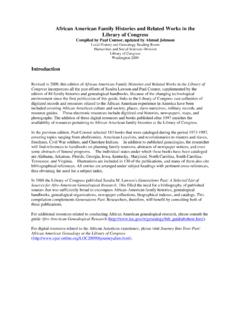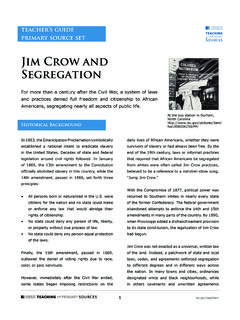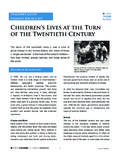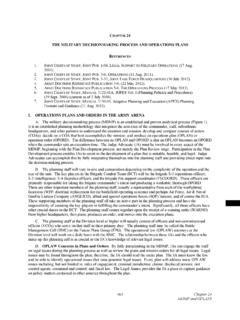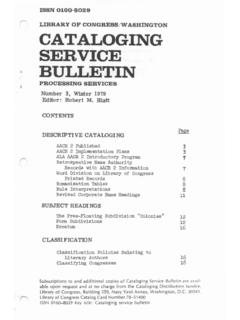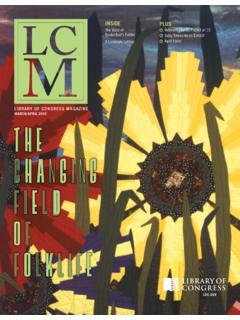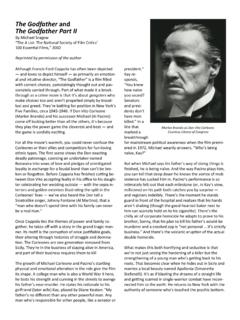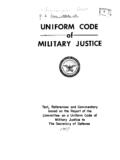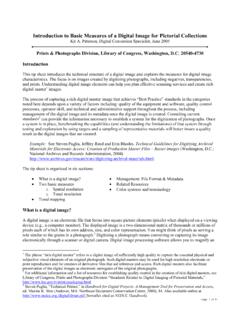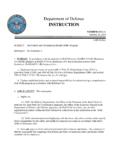Transcription of Chinese romanization table - Library of Congress
1 Chinese RULES OF APPLICATION romanization 1. ALA-LC romanization of ideographic characters used for the Chinese language follows the principles of the Pinyin ( spell sound ) system. The Pinyin system was developed in the mid 20th century for creating Latin script readings for Chinese script ideographic characters. It replaces the Wade-Giles system of romanization specified in earlier editions of the ALA-LC romanization Tables. The Pinyin system as outlined in Han yu pin yin fang an (1962) is followed closely for creating romanizations except that the ALA-LC guidelines do not include the indication of tone marks. 2. Standard Chinese national (PRC) pronunciation is used as the basis for creating the Latin script reading of a character. When it is necessary to make semantic distinctions between multiple readings of a single character, rely upon the usage of the most recent comprehensive edition of Ci hai (published in China by Shanghai ci shu chu ban she).
2 To determine contemporary pronunciation, or when there is a conflict in pronunciation between different sources, it is appropriate to follow the guidance of a more recent dictionary (such as Xian dai Han yu ci dian , Zhonghua da zi dian , Han yu da ci dian , and/or Xin Hua zi dian ). More specialized dictionaries (such as Zhongguo li dai yi jia zhuan lu , published 1991) may be consulted if necessary. Judgment should be used in choosing between modern authoritative dictionaries and older standard dictionaries. 3. Romanize words of non- Chinese origin systematically in all cases, even though normalized non-systematic romanizations are known or the word comes from a Latin script language. Wulumuqi not Urumchi Haerbin Shi not Harbin Zhijiage not Chicago Dongjing not Tokyo Separation of Syllables Separate the romanization of each Chinese character with a space.
3 This includes corporate names, terms of address and titles of royalty. Do not join syllables of general, non-specific geographic terms. Ming Qing xiao shuo bi jiao yan jiu Li Bai he ta de shi ge Di zhen wen hua yu she hui fa zhan Shang wu yin shu guan Li Denghui xian sheng yan lun ji Ta er si xiu shan gong cheng bao gao Zhongguo lao nian wen wu yan jiu xue hui Xi bei guo mian si chang 1. Terms of address. A term of address may follow a surname, a courtesy name, or another appellation. Separate syllables in the term of address. If a term appearing as an integral part of a name is not a title or term of address, romanize the name in running form, as a forename (see below). Lin lao shi Wei dai fu Baisha xian sheng Huian xian sheng Jiang Jingguo xian sheng 2.
4 Titles, and titles of royalty. Syllables in a title should be separated and written in lower-case. If a term appearing as an integral part of a name is not a title or term of address, romanize the name in running form, as a forename. An epithet is separated from the name of a person, using lower case letters and separated syllables. Donge fei Cixi huang hou Qin shi huang di Yang tai hou 3. General, non-specific geographic terms. Some terms have both general and specific usage, depending upon context. For example, when the term refers to the direction northeast, or, in a general way, to the Northeast, separate syllables; when it is used to refer specifically to Manchuria, capitalize and join syllables. Hua dong xi bei dong bei Shan bei But: Dongbei lin xue yuan Connection of syllables 1.
5 Join together (without spaces or hyphens) the syllables associated with multi-character surnames and given names. Also join together given names, Buddhist names, courtesy names, etc., in more than one syllable. For example: Sun Zhongshan Ouyang Xiu Sima Xiangru Nikesen Kang Youwei 1A. Forenames, given names, courtesy names. A forename does not include a person's surname. Only capitalize the first letter of a forename. If a term appearing as an integral part of a name is not a title or term of address, romanize the name in running form. Wumingshi Wugangzhuren Yungulaoren Kongzi Laozi Haoran 1B. Married women. Separate and capitalize family names. Jiang Song Meiling Chen Zhao Yueying 1C. Fictional characters. The names of fictional characters are romanized in the same manner as those of real people.
6 Luotuo Xiangzi Qin Keqing 1D. Names of persons of religious vocation. Separate a term of address from a family name or forename. Huineng shi Jizang Zhiyi da shi sha men Yuanxian 1E. Personal names appearing as part of the names of corporate bodies and meetings are romanized in the same manner as all other personal names. (See also Section 2J.) Zhongshan da xue Liu Shaoqi yan jiu lun wen ji bian ji zu Zhou Enlai yan jiu xue shu tao lun hui 2. Join together (without spaces or hyphens) the syllables associated with multi-character geographic names. Do not join the names of jurisdictions and topographical features to geographic names, but separate them from the proper name by a space. Zhonghua Renmin Gongheguo shi gao Taiwan Sheng li bo wu guan Xizang Zizhiqu wen wu guan li wei yuan hui Dongbei lin xue yuan Yangzi Jiang Guangzhou Shi Anhui Sheng Shangqiu Diqu Lugang Zhen Niuyue Shi Gannan Zangzu Zizhizhou Cuiheng Cun Putang Xiang Hainan Dao 2A.
7 Names of countries. Connect syllables according to the practice followed by the Board on Geographic Names. Zhonghua Renmin Gongheguo Chaoxian Minzhu Zhuyi Renmin Gongheguo Zhonghua Minguo Minguo dang an yu Minguo shi xue shu tao lun hui lun wen ji Eguo xi ju shi gai yao 2B. Generic terms for geographical features are capitalized and separated from the names of the features. The syllables of the name of a jurisdiction or geographic feature that are included within another place name are connected together. These practices are also followed when geographic names appear within corporate names. In case of doubt, separate. Hainan Dao Taiping Yang Chang Jiang Changjiang Kou not Chang Jiang Kou Chang Jiang da fan dian not Changjiang da fan dian Zhu Jiang shui chan yan jiu suo Fen He Fenhe Shuiku Fanjing Shan Fanjingshan Ziran Baohuqu Heilongjiang Sheng Huangtu Gaoyuan Yindu Bandao 2C.
8 Two-syllable place names, in which the second syllable is a generic term. Separate and capitalize a generic term for the jurisdiction. Wu Xian Qi Xian 2D. Place names consisting of more than two syllables. Separate and capitalize a generic term for the jurisdiction. Anhui Sheng Guangzhou Shi Gaoxiong Shi Baoshan Qu Lugang Zhen Cuiheng Cun Shangqiu Diqu Gannan Zangzu Zizhizhou 2E. Obsolete terms for administrative units are romanized in the same manner as the names of contemporary places. Funing Zhou Changping Zhou Jinzhou Fu Anshun Fu 2F. Names of non- Chinese jurisdictions are romanized in the same manner as the names of Chinese jurisdictions. Jia Zhou Niuyue Shi Ya Zhou Dong nan Ya 2G. Terms for archaeological sites, bridges, and other constructions of geographic extent are capitalized and separated from the names themselves.
9 Individual syllables of multi-syllable generic terms are connected together. Individual syllables of multi-syllable generic terms are connected together, as are the syllables of the names of a jurisdiction or geographic feature that are included within the term. Luzhou Changjiang Daqiao not Luzhou Chang Jiang Daqiao Huangbizhuang Shuiku not Huangbi Zhuang Shuiku Jing Hang Yunhe 2H. Names of buildings and other constructions of less than geographic extent. Syllables are separated and not capitalized, except for proper nouns. Huang he lou Sheng guo si 2I. Names of continents and regions. Generic terms are separated and capitalized in the names of continents and regions. Distinguish when a term refers to a region, and when it refers to direction or position. Ya Zhou Dong nan Ya Bei Mei Zhou dong bei (when referring to direction or position) But: Dongbei (when referring to the particular area formerly known as Manchuria) 2J.
10 The syllables of personal names that appear within geographic names are connected together. The generic term for the jurisdiction or geographic feature is separated. This rule is an exception to Section 1E. Zhangzizhong Lu Zuoquan Xian Luxun Gongyuan 3. Join together transliterations of two or more characters comprising the names of racial, linguistic, or tribal groupings of mankind. Join the term zu (for tribe or people) to a name only in proper names of places. Jidu tu Tongcheng pai Maonan zu Meiguo ren Kejia hua Miao zu feng qing lu But: Dehong Daizu Jingpozu Zizhizhou 4. Add an apostrophe before joined syllables that begin with a vowel in cases of ambiguity. For example: Chang an Shi to distinguish it from Changan Shi Yan an Shi to distinguish it from Yanan Shi Zhang Zhang ang to distinguish it from Zhang Zhangang Liu Zheng an to distinguish it from Liu Zhengan Wang Jian an to distinguish it from Wang Jianan Capitalization 1.
